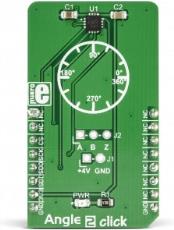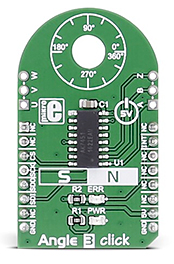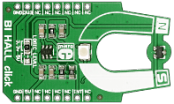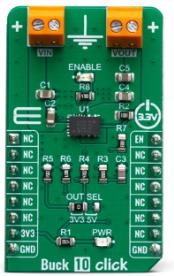Search
Search for "click":
(Click here to search this entire website for "click" with Google.)
 |

|
|
Ammeter click is a mikroBUS add-on board with circuitry for measuring electric current (both AC and DC).
Two onboard screw terminals (probe+ and probe-) are bringing in the current, which then passes through a shunt resistor. A voltage proportional to the strength of the current is generated accross the resistor. This voltage passes through an amplifier before it's fed into a 12-bit ADC which then outputs a digital value through the mikroBUS SPI interface.
The firmware processes the digital value to determine the exact amperage between 1mA and 1A for DC current. It's also possible to measure AC current by deriving the value from peak to peak measurements. At the same time, the voltage can be directly monitored through the AN pin.
The board uses either a 3.3V or 5V power supply (it's important not to power the board from the same power source you wish to measure). |
|
|
|
 |

|
|
Angle 2 click is a magnetic rotational sensor which relies on the ultra-fast MA700 angular sensor IC. Due to a high data output rate of 500kHz, the MA700 IC is able to provide a reliable absolute angular positional data at speeds up to 100,000 RPM. This can be achieved by utilizing the advanced Spinaxis technology based on a direct angle sampling approach, instead of using the extensive arctangent computations and other similar solutions. This also allows for relaxed mechanical tolerances, allowing even the off-axis magnetic field to be used.
It comes in the package which also includes the mikroSDK™ software and a library with all the functions. The Click board™ comes as a fully tested and approved prototype, making it a reliable device ready to use on the development board.
|
|
|
|
 |

|
|
Angle 3 click carries the AK7451, a magnetic rotational angle sensor. The click is designed to run on a 5V power supply. It communicates with the target microcontroller over SPI interface, with additional functionality provided by the INT pin on the mikroBUS™ line. |
|
|
|
 |

|
|
Angle 4 click is an angular magnetic rotary sensor, which can be used as a rotary encoder. With the help of the AEAT-8800-Q24, an integrated 10 to 16-bit programmable angular magnetic encoder, the Angle 4 click can sense the magnetic field rotation aligned with the center of the sensor, over the whole range of 360°. The absolute angular position can be read from the SPI interface. The sensor IC itself offers a versatile contactless rotation sensing platform, with the ability to fine-tune several important working parameters, such as the resolution, zero position, direction, hysteresis, and more. |
|
|
|
 |

|
|
Barcode click is a very fast and agile barcode scanner on a click board™, which is compliant with a wide range of different 1D and 2D barcode protocols. The barcode scanner module is equipped with the micro USB port; thus, it can work both as a standalone device and a standard click board™, which communicates with the MCU via the RX, TX, RST and PWM pin of the mikroBUS™. The barcode module has two red LEDs, used to illuminate the area in low light conditions. Also, Barcode click features two push buttons, used to control the device when working as a standalone device. |
|
|
|
 |

|
|
Bi Hall click is a simple solution for adding a bipolar Hall switch to your design. It carries the Melexis US2882 bipolar Hall-effect switch and a 74LVC1T45 single bit, dual supply transceiver. A bipolar Hall effect sensor is sensitive to both north and south pole magnetic fields. Bi Hall click outputs a HIGH logic level when exposed to a south pole magnetic field, and a LOW logic level when exposed to a north pole magnetic field. When removed from a magnetic field, the logic level stays in its previous state. The US2882 IC integrates a Schmitt trigger with hysteresis, thus preventing output oscillation near the switching point between alternating magnetic poles. Bi Hall click communicates with the target board through the mikroBUS INT line. It's designed to use either a 3.3V or a 5V power supply. |
|
|
|
 |

|
|
BOOST 2 click is a DC-DC step-up (boost) regulator that has a fixed 5V output, which can be obtained from any low voltage input - such as NiCd, NiMH or one cell Li-Po/Li-Ion batteries. This click features very high efficiency, low noise and anti-ringing voltage output and inrush current limiting with the internal soft-start, as well as true disconnect option for minimized power drain, when in shutdown mode.
These features allow this device to be used as the power source for various battery-operated devices, especially for those which require 5V, such as the PIC® family of microcontrollers, various portable embedded electronic devices, handheld instruments, GPS modules, or various battery-operated USB emergency backup chargers. Very good switching efficiency factor ensures prolonged battery life for any application this device is used in. |
|
|
|
 |

|
|
Boost 4 click carries the TPS61230A, a high efficiency fully integrated synchronous boost converter from Texas Instruments. The click is designed to run on a 3.3V power supply. Boost 4 click drives the target chip through the digi pot, which has SPI communication with the microcontroller on the system. |
|
|
|
 |

|
|
The Boost 6 Click is a Click board™ which features the TPS55332-Q1, a monolithic high-voltage switching regulator with integrated 3-A, 60-V power MOSFET. The device can be configured as a switch mode step-up power supply with voltage supervisor. This Click board™ can be used for applications regarding lighting, battery powered and automotive applications.
The Boost 6 click is supported by a mikroSDK compliant library, which includes functions that simplify software development. This Click board™ comes as a fully tested product, ready to be used on a system equipped with the mikroBUS™ socket.
|
|
|
|
 |

|
|
Buck 10 Click is a high-efficiency step-down converter which provides a highly regulated output voltage derived from the connected power source, rated from 4V to 18V. The regulated output voltage can be selected between two values: 3.3V and 5V. These are voltage values ??that are most commonly used in many embedded designs. This click is based around an integrated DC-DC converter, labeled as MPM3632C. Due to its high efficiency, MPM3632C allows the Click board™ to easily deliver up to 3A of current. The MPM3632C is very reliable, offering over-current and over-voltage protection, as well as a thermal shutdown.
Buck 10 click is supported by a mikroSDK compliant library, which includes functions that simplify software development. This Click board™ comes as a fully tested product, ready to be used on a system equipped with the mikroBUS™ socket.
|
|
|
|
 |
|
<< First
< Previous
Next >
|
|

